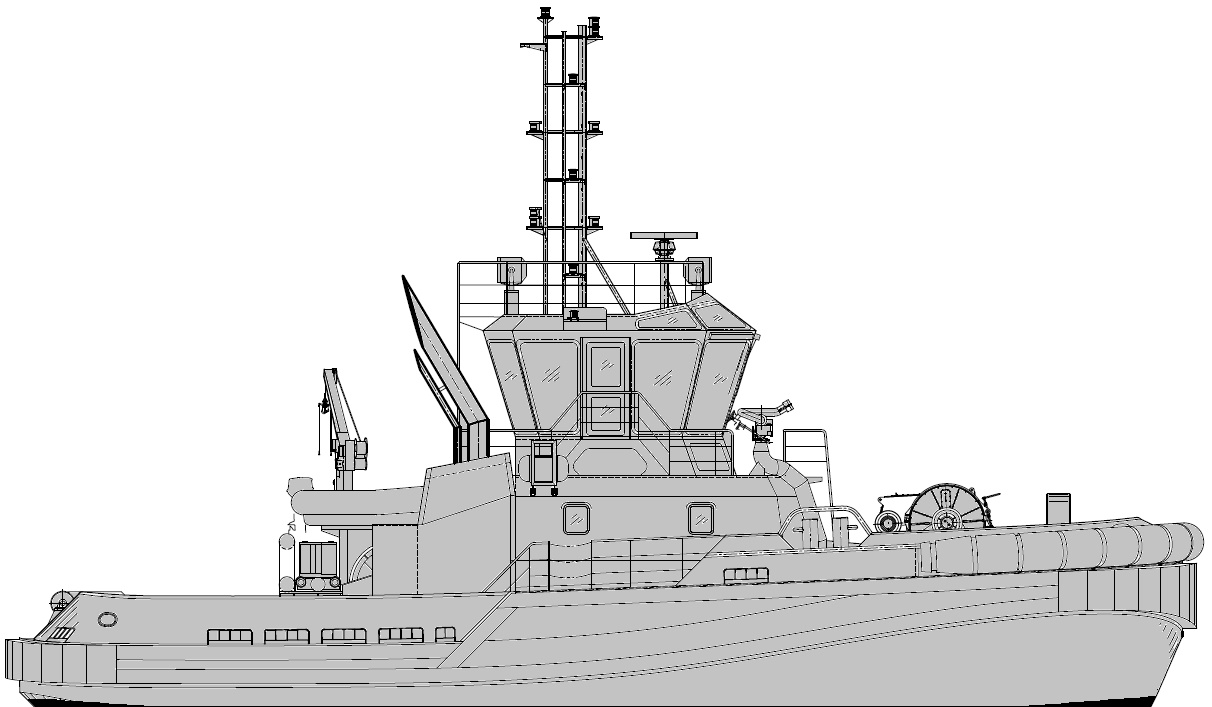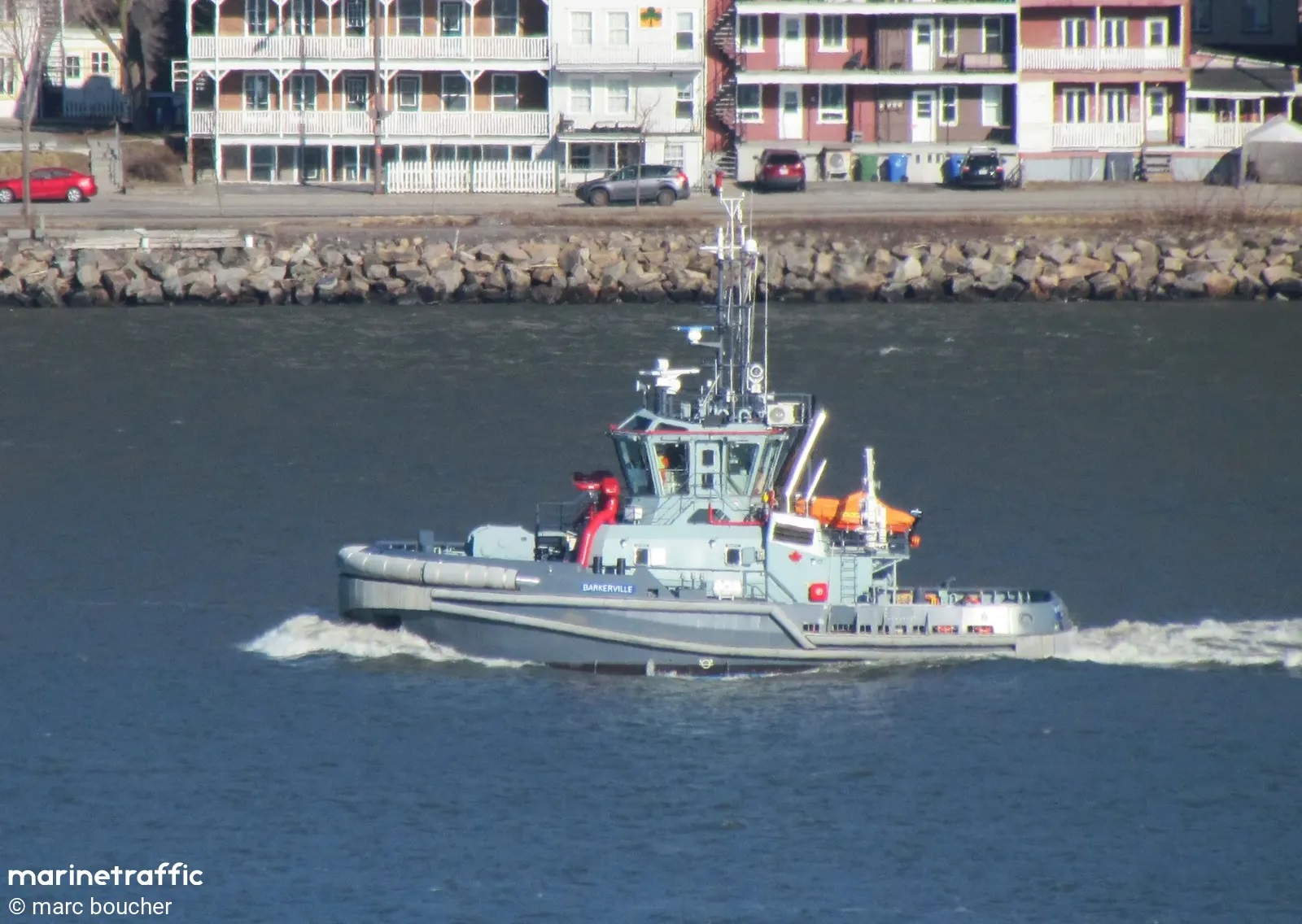 |
Line drawing of the HARO class tug . Click on image to enlarge. (Provided by Colin Darlington) ) |
HARO is the class of this vessel. Latge Naval Tug (LNT) is the project title.On December 9th, 2021, the Royal Canadian Navy announced tthe names of the four new tugs that will pay homage to Canada’s extensive maritime history. “I am pleased today to announce the names of the Royal Canadian Navy’s new fleet of large naval tugs . Haro, Barkerville, Canso and Stella Maris provide important linkages to Canada’s rich maritime history and their role is tied to our future,” said Vice-Admiral (VAdm) Craig Baines, Commander of the Royal Canadian Navy. The new tugs will replace four of the Glen class tugs currently serving in the fleet.
| NAME OF VESSEL | PENNANT | LAID DOWN | LAUNCHED | IN SERVICE* | ASSIGMED TO | RADIO
CALLSIGN |
| CFAV HARO | ? | September 2020 | 15 Jul 2022 | Yes | Maritime Forces Pacific | CFA 3868 |
| CFAV BARKERVILLE | ? | ? | ? | Yes | Maritime Forces Pacific | CFA 4172 |
| CFAV CANSO | ? | ? | ? | ? | Maritime Forces Atlantic | ? |
| CFAV STELLA MARIS | ? | ? | ? | ? | Maritime Forces Atlantic | ? |
* CFAVs are not commissioned. They are manned with civilian masters and crews.
The four HARO class tugs are being built by Ocean Industries Inc. of Isle-aux-Coudres, Quebec, under the National Shipbuilding Strategy, and are named after tugs that perished in the performance of their duties or locations on the East and West coasts that are linked to RCN maritime heritage.CFAV Haro is named after the Haro Strait, which connects the Straits of Georgia and Juan de Fuca in British Columbia, and is frequently transited by RCN vessels proceeding north from Esquimalt, the home of the RCN Pacific Fleet. HARO’ sailed the waters between 1910 and 1970. During WWII, HARO served in the RCN as P06/Z06(N) where she had duties as an examination vessel and patrol ship. HARO was commanded for a period by Lt W.R. Stacey RCNR. After WWII, she was purchased by the Island Tug and Barge Company and served as a Canadian west coast commercial tug.
CFAV Barkerville takes its name from the Second World War-era Ville-class tug of the same name, which sank on December 17, 1945 at the entrance of Bedwell Harbour, B.C., while towing His Majesty’s Canadian Ship (HMCS) Hespeler to its mooring. The Ville-class tug was named after the town of Barkerville, located in Central British Columbia.
CFAV Canso is named after the Canso Strait, which separates Nova Scotia from Cape Breton Island. The region figures prominently in Canada’s formative history, and in the RCN’s past with HMCS Canso, a Bangor-class minesweeper that served in the Pacific and Atlantic during the Second World War and was on hand for D-Day.
CFAV Stella Maris is named in recognition of the valiant actions of the crew of the tug of the same name that came to the assistance of the Steam Ship (SS) Mont Blanc, a French munitions ship laden with explosives, on December 6, 1917 in Halifax. The Mont Blanc had collided with the Norwegian SS Imo, staring a fire on the French ship that forced the crew to evacuate. Stella Maris was the first to arrive at the burning munitions ship, spraying the flames with its fire hose. As the fire was too intense to stop with a single fire hose, the Stella Maris’s crew began to prepare a towline to pull the French vessel away from Pier 6 to prevent the fire from spreading ashore. The crew were in the process of retrieving a 10-inch hawser from the hold to assist a party of volunteers from HMCS Niobe’s steam pinnace in securing a line to Mont Blanc. Before this could be done, the now-infamous Halifax Explosion occurred.
Stella Maris was severely damaged and thrown up on the beach near Pier 6 with the bow ashore and the shattered stern submerged. Nineteen of the crew were killed, including Captain Horatio Harris Brannen. Miraculously, five managed to survive.
 |
Line drawing of the HARO class tug . Click on image to enlarge. (Provided by Colin Darlington) ) |
Today, navy tugs continue to be an important component of the RCN fleet, performing a wide variety of tasks including harbour berthing, coastal towing, harbour firefighting and other naval fleet support duties. The new tugs will replace the current Glen-class fleet, which were acquired in the mid-1970s and are reaching the end of their service life.Serving on both coasts, this new, more powerful fleet of tugs will support the RCN’s current and future fleets, including the six Arctic and Offshore Patrol Ships, two of which have already been received, two Joint Support Ships and 15 Canadian Surface Combatants.
The steel cutting for the first tug began in September 2020, with formal construction following in November 2020. The first two tugs are expected to be launched in April 2022 and June 2022, respectively, with first deliveries expected by the fall of 2022.
SPECIFICATIONS:
Source: RCN HQ PA
– Vessel type: TBA. Likely it will be YTB 6xx series
– LOA: 24.4m
– Breadth: 11.25m
– Draft: 5.10m
– Bollard pull: 60 tonnes (This is 3 times more powerful than the current GLEN tugs)
– Speed: 12 knots
– Propulsion: Azimuth stern drive
– Crew Complement: 6 . The tug will be crewed to Transport Canada standards and will have accommodations, heads and wash places for a mixed-gender crew of up to six. Capable of in-harbour and near coastal operations.PULLING POWER
The Glen-class tugs have a bollard pull of about18 tonnes of force and 850 horse power on each side. The new HARO class tug outpowers them with 60 tonnes of force which will enable them to pull and move much larger, heavier vessels, even in heavy winds and strong currents.
Another key difference is the Azimuth Stern Drive propulsion that will provide the new tugs more power at 4988 horse power per side.
 |
| CFAV BARKERVILLE. Click on image to enlatge. (Photo by Marc Boucher, Marine Traffic web site) |
Credits and References and sources:1) https://www.canada.ca/en/department-national-defence/news/2021/12/royal-canadian-navy-announces-names-of-naval-large-tugs.html
2) https://publications.gc.ca/collections/collection_2021/mdn-dnd/D12-21-97-eng.pdf
3) Colin Darlington
4) Nauticapedia
5) Robert Stacey [rstacey1(at)yahoo.ca]
6) Canadiaan Warship Names by David Freeman
7) Pulling power https://www.lookoutnewspaper.com/more-powerful-tugboats-coming-to-auxiliary-fleet/July 23/24 Back to Table of Contents